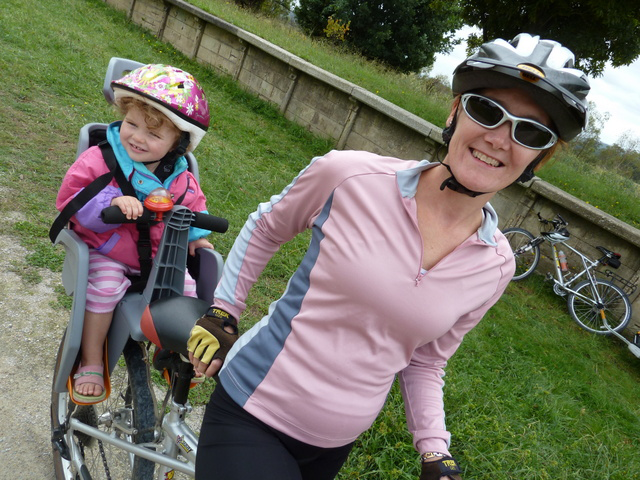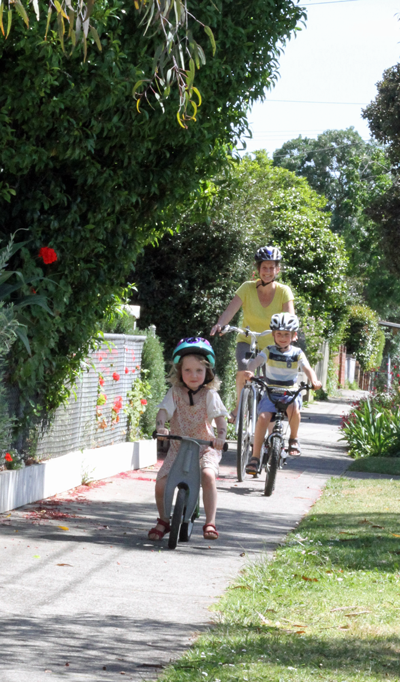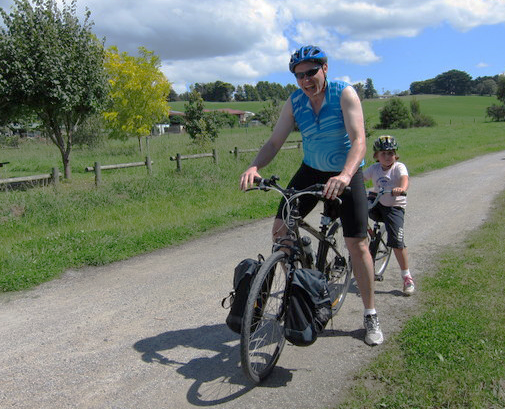There are many great reasons to ride together as a family. Nicola Rutzou looks at ways to encourage parents and children to get on two wheels and active.
Family life is often frantic and fraught, so it’s important to take time out to spend together. What better way than by getting on a bike and riding?
There are many benefits for families that come from being on a bike. It’s a fun activity everyone in the family can share, introduces healthy habits and valuable skills to children that they’ll take with them throughout their life, and, it’s a great way to increase confidence as a family unit.
There’s a number of things parents can do to acclimatise their kids to being on the bike—the earlier the better—and they can do it through what I like to call the three stages of learning to ride.
The first stage is when children can’t ride independently (as they’re babies), the second is when they start to ride alongside you but still need constant supervision, and the third is when they can ride on their own and you can start enjoying family trips on two wheels.
The age at which children reach each of these stages will vary depending on their confidence and ability and your willingness to be involved.
In the first stage, there are a number of options available for parents to transport children at by using baby seats and trailers. It’s advised to wait until your baby is strong enough to sit independently, has strong head control, and can fit into a child’s cycling helmet (and keep it on!)So it’s best to wait till they’re about 12 months old before taking them on a ride.

Trailers towed behind a bike are another option and can seat one or two children, however, children are much further away and close to the ground which some parents are not comfortable with.
As they get older you can also consider tagalongs which allow children to ride behind while still being firmly attached to the bike.
As they get older, balance bikes (small bikes with no cranks or pedals) allow children to learn to balance and steer and use their feet to scoot along. They also allow an easy transition to a bike with pedals and cranks and no training wheels.
From personal experience I can tell you that they are great for kids to ride around the backyard or a safe location under supervision so they can learn about riding and reach the second stage of riding alongside you.
Once your children are ready to ride with you without training wheels, parents can find a safe location like a park with dedicated cycle paths.
Keep these first rides short and include a destination like a café or ice cream shop so they get a reward for their hard work on the pedals.

During this second stage it’s also important to make sure children are aware of the road rules and their responsibilities as road users.
Make your children aware that most offroad bike paths are shared with pedestrians, and teach them to signal with their bell. Be on the lookout for other cyclists as well and do your best to help your kids be aware too. Communicate with them any hazards you see and get them to pull over to the side if necessary.
Kids get bored and are easily distracted, which can be a dangerous combination. So watch out for them losing interest. Stay close and stop for plenty of breaks to keep up their enthusiasm.
When your family is ready for stage 3—riding independently—make sure everyone has the right set up.
Ensure bikes fit and are in good working order. Regularly maintain them by checking tyre pressure, that the chain is lubricated and that the seat and handlebar heights are correct. Getting them serviced at your local bike shop is a good way to ensure they’re in tiptop shape.
The type of bikes you’ll need will vary according to the terrain you want to tackle i.e. hills, roads, paths, offroad so ask for advice if you need it.
Getting a bike rack fitted to the car is also a great idea, especially for those weekend jaunts to a favourite family spot to ride.
The best tip for all stages of family bike riding is to make it fun and make it a habit. Focus on the fun part of bike riding and make it a regular family activity so that everyone can benefit from being active on a bike.
Ride On content is editorially independent, but is supported financially by members of Bicycle Network. If you enjoy our articles and want to support the future publication of high-quality content, please consider helping out by becoming a member.

